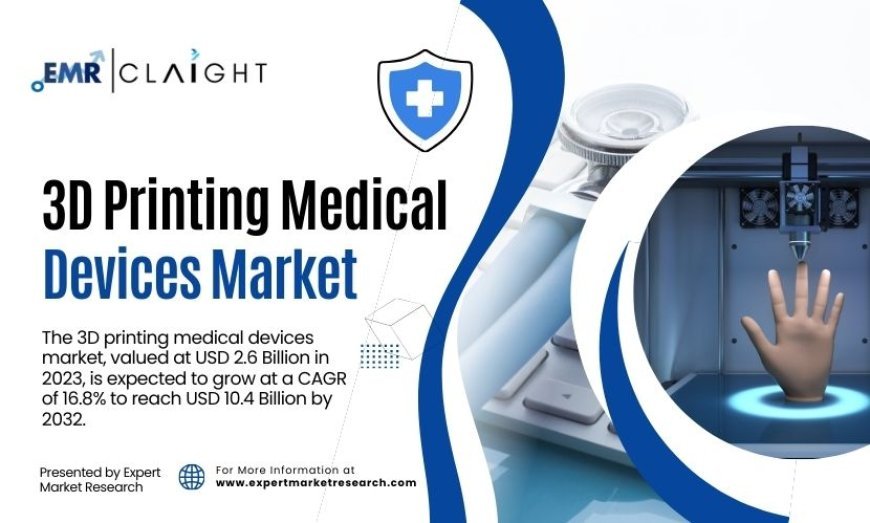3D Printing Medical Devices Market Size, Share & Analysis Forecast 2034

3D Printing Medical Devices Market Overview
The 3D printing medical devices market is an innovative and rapidly growing sector within healthcare, utilizing additive manufacturing techniques to produce customized medical devices. The technology has revolutionized the way medical devices are designed, developed, and manufactured, enabling the creation of tailored implants, prosthetics, and surgical tools. By reducing lead times, minimizing waste, and improving precision, 3D printing offers numerous advantages for both manufacturers and patients. This market is driven by advancements in 3D printing technology and increasing investments by major healthcare players, with the forecast indicating substantial growth in the coming decade.
3D Printing Medical Devices Market Size
The global 3D printing medical devices market was valued at USD 2.6 billion in 2024 and is projected to grow at an impressive CAGR of 16.8% during the forecast period of 2025 to 2034. As the healthcare industry continues to embrace technological innovations, the market size is expected to reach USD 10.4 billion by 2034. This substantial growth is fueled by the rising demand for personalized medicine, custom prosthetics, and implants, along with the growing adoption of 3D printing technologies by medical professionals and manufacturers. The market's expansion is also driven by advancements in material sciences and regulatory approvals.
3D Printing Medical Devices Market Share
The 3D printing medical devices market is experiencing a significant shift in its competitive landscape, with key players such as Stratasys, 3D Systems, and Materialise holding substantial shares. The market is highly fragmented, with companies across different segments, including implantable devices, prosthetics, and surgical tools. The North American region, led by the United States, holds the largest market share, driven by increased adoption and significant investments in healthcare innovation. However, Europe and Asia Pacific are emerging as lucrative markets, with growing interest in medical applications and expanding healthcare infrastructure in developing economies.
3D Printing Medical Devices Market Trends
Several key trends are shaping the 3D printing medical devices market. One major trend is the increasing demand for personalized medicine, with 3D printing enabling customized prosthetics, implants, and orthotics tailored to individual patients. Additionally, advancements in bioprinting technologies are revolutionizing the development of tissue engineering and organ printing. Another important trend is the shift toward more cost-effective, efficient manufacturing methods, with 3D printing offering faster production cycles and reducing material waste. Lastly, growing collaborations between medical professionals, research institutions, and 3D printing companies are accelerating innovations and the commercialization of medical 3D printing solutions.
3D Printing Medical Devices Market Analysis
The 3D printing medical devices market has witnessed tremendous growth in recent years and is poised for continued expansion. Technological advancements, such as improved 3D printing materials and bioprinting technologies, have made it possible to create complex and highly customized medical devices that were previously impossible to manufacture. 3D printing is increasingly being used for personalized prosthetics and implants, where customization is critical to ensuring a perfect fit and improving patient outcomes. Moreover, the ability to produce devices quickly and with reduced production costs has made it an attractive option for healthcare providers looking to improve patient care while reducing expenses. The growing acceptance of 3D printed devices by regulatory authorities, such as the FDA, has also contributed to the market’s growth. With increased healthcare spending and rising demand for advanced medical solutions, the market is expected to maintain a robust growth trajectory, reaching USD 10.4 billion by 2034.
3D Printing Medical Devices Market Segmentation
The 3D printing medical devices market can be segmented based on various factors:
-
By Technology: This includes Stereolithography (SLA), Fused Deposition Modeling (FDM), Selective Laser Sintering (SLS), and others. SLA holds the largest market share due to its precision and ability to create detailed structures.
-
By Application: The market includes implants, prosthetics, surgical instruments, and dental devices. Implants and prosthetics are the most significant segments, driven by the demand for personalized healthcare solutions.
-
By End-User: Hospitals, clinics, research laboratories, and others. Hospitals are the largest end-user segment, as they are the primary users of customized implants and surgical tools.
-
By Material: The market includes metals, polymers, and biomaterials. Polymers are widely used due to their cost-effectiveness and flexibility.
-
By Region: North America, Europe, Asia Pacific, Latin America, and Middle East & Africa. North America leads the market, driven by technological advancements and high healthcare investments.
Get a Free Sample Report with Table of Contents
3D Printing Medical Devices Market Growth
The 3D printing medical devices market is poised for exceptional growth, with a CAGR of 16.8% from 2025 to 2034. This growth is fueled by increasing adoption of personalized medical devices, advancements in bioprinting technologies, and the growing focus on cost-effective manufacturing solutions. The expansion of healthcare infrastructure, particularly in emerging economies, is also contributing to the market's growth. As 3D printing technologies continue to evolve, enabling more complex and precise medical devices, the demand for these innovations is expected to accelerate. By 2034, the market is expected to reach a value of USD 10.4 billion.
Recent Developments and Challenges in the 3D Printing Medical Devices Market
The 3D printing medical devices market has seen several important developments recently, including breakthroughs in bioprinting and advancements in material science. Companies are increasingly focusing on developing bio-compatible materials, such as polymers and metal alloys, to enhance the performance and durability of 3D printed devices. Additionally, advancements in regulatory approvals and certifications are streamlining the path to commercialization for 3D printed medical devices. However, the market faces several challenges, such as the high costs associated with 3D printing technologies, the need for specialized equipment, and the complexity of regulatory hurdles. The industry also needs to address concerns related to intellectual property rights and standardization of manufacturing practices. Despite these challenges, the increasing demand for customized, cost-effective, and faster medical device solutions is driving the market forward, presenting opportunities for both new entrants and established companies to innovate and capture market share.
Key Players in the 3D Printing Medical Devices Market
The 3D printing medical devices market is highly competitive, with several leading companies contributing to its growth and innovation. Key players in the market include:
-
Stratasys Ltd. – A global leader in 3D printing, Stratasys provides a range of additive manufacturing solutions, including those tailored for the healthcare sector.
-
EnvisionTEC – Known for its precision 3D printing technology, EnvisionTEC specializes in medical applications, including hearing aids, dental devices, and more.
-
Koninklijke Philips N.V. – A significant player in the healthcare technology industry, Philips offers 3D printing solutions for medical imaging and device manufacturing.
-
3D Systems, Inc. – A pioneer in 3D printing, 3D Systems offers solutions for medical device manufacturing, with a focus on personalized medicine.
-
EOS – Specializes in industrial 3D printing solutions, including those used for medical device manufacturing, focusing on metal and polymer materials.
-
Renishaw plc. – Known for its advanced 3D printing solutions in the medical field, Renishaw focuses on custom implants and surgical tools.
-
Materialise – A leading provider of 3D printing services and software solutions for the medical sector, Materialise offers services for personalized implants and surgical planning.
-
3T Additive Manufacturing Ltd. – Specializes in medical device manufacturing, offering 3D printed implants and tools for the healthcare sector.
-
GENERAL ELECTRIC COMPANY – GE's Healthcare division is focusing on the development of 3D printing technologies for medical applications.
-
Carbon, Inc. – Known for its innovative digital light synthesis (DLS) 3D printing technology, Carbon focuses on manufacturing medical devices with high precision.
-
Prodways Group – A key player in the 3D printing market, offering solutions for producing medical devices, including implants and prosthetics.
-
SLM Solutions – Focuses on metal-based 3D printing solutions, which are used in the production of custom medical implants.
-
Organovo Holdings Inc. – Specializes in bioprinting technologies, with a focus on creating functional human tissues for medical applications.
-
Anatomics Pty Ltd. – Known for its custom 3D printed implants and medical devices, particularly in the field of orthopedic surgery.
-
Groupe Gorgé – A leading player in the 3D printing of medical devices, specializing in customized implants and surgical tools.
What's Your Reaction?
































































